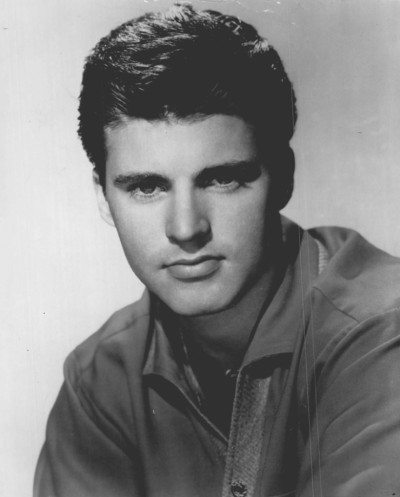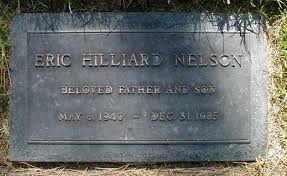Rick Nelson (Eric Hilliard Nelson)

Rick Nelson
Nelson dreaded flying but refused to travel by bus. In May 1985, he decided he needed a private plane and leased a luxurious, fourteen-seat, 1944 Douglas DC-3 that had once belonged to the DuPont family and later to Jerry Lee Lewis. The plane had been plagued by a history of mechanical problems. In one incident, the band was forced to push the plane off the runway after an engine blew, and in another incident, a malfunctioning magneto prevented Nelson from participating in the first Farm Aid concert in Champaign, Illinois.
On December 26, 1985, Nelson and the band left for a three-stop tour of the Southern United States. Following shows in Orlando, Florida, and Guntersville, Alabama, Nelson and band members took off from Guntersville for a New Year’s Eve extravaganza in Dallas, Texas. The plane crash-landed northeast of Dallas in De Kalb, Texas, less than two miles from a landing strip, at approximately 5:14 p.m. CST on December 31, 1985, hitting trees as it came to earth. Seven of the nine occupants were killed: Nelson and his companion, Helen Blair; bass guitarist Patrick Woodward, drummer Rick Intveld, keyboardist Andy Chapin, guitarist Bobby Neal, and road manager/soundman Donald Clark Russell. Pilots Ken Ferguson and Brad Rank escaped via cockpit windows, though Ferguson was severely burned.
Nelson’s remains were misdirected in transit from Texas to California, delaying the funeral for several days. On January 6, 1986, 250 mourners entered the Church of the Hills for funeral services while 700 fans gathered outside. Attendees included ‘Colonel’ Tom Parker, Connie Stevens, Angie Dickinson, and dozens of actors, writers, and musicians. Nelson was privately buried days later in the Forest Lawn, Hollywood Hills Cemetery in Los Angeles, California.[106] Kris Nelson threatened to sue the Nelson clan for her former husband’s life insurance money and tried to wrest control of his estate from David Nelson, its administrator. Her bid was rejected by a Los Angeles Superior Court judge. Nelson bequeathed his entire estate to his children and did not provide for Eric Crewe or Kris Nelson. Only days after the funeral, rumors and newspaper reports suggested cocaine freebasing was one of several possible causes for the plane crash. Those allegations were refuted by the National Transportation Safety Board (NTSB).
Reports vary as to whether or not the plane was on fire before it crashed. According to witnesses, the plane appeared to be on fire before it crash-landed. However Jim Burnett, then-Chairman of the NTSB, said that even though the plane was filled with smoke, it landed and came to a stop before it was swallowed by flames. The NTSB conducted a year-long investigation and finally concluded that, while a definite cause was still unknown, the crash was probably due to a fire that was caused by the plane’s cabin heater “acting up”.
When questioned by the NTSB, pilots Brad Rank and Ken Ferguson had different accounts of key events. According to co-pilot Ferguson, the cabin heater was acting up after the plane took off. Ferguson continued that Rank kept going to the back of the plane to see if he could get the heater to function correctly and that Rank told Ferguson several times to turn the heater back on. “One of the times, I refused to turn it on,” said Ferguson. He continued, “I was getting more nervous. I didn’t think we should be messing with that heater en-route.” After the plane crashed, Ferguson and Rank climbed out the windows, suffering from extensive burns. They shouted to the passenger cabin, but there was no response. Ferguson and Rank backed away from the plane, fearing explosion. Ferguson stated that Rank told him, “Don’t tell anyone about the heater, don’t tell anyone about the heater.”
Pilot Rank, however, told a different story: Rank said that he was checking on the passengers when he noticed smoke in the middle of the cabin, where Rick Nelson and Helen Blair were sitting. Even though he never mentioned a problematic heater, Rank stated that he went to the rear of the plane to check the heater, saw no smoke, and found the heater was cool to the touch. After activating an automatic fire extinguisher and opening the cabin’s fresh air inlets, Rank said that he returned to the cockpit where Ferguson was already asking traffic controllers for directions to the nearest airfield.
Rank was criticized by the NTSB for not following the in-flight fire check-list, opening the fresh air vents instead of leaving them closed, not instructing the passengers to use supplemental oxygen, and not attempting to fight the fire with the hand-held fire extinguisher that was in the cockpit. The board said that while these steps might not have prevented the crash, “they would have enhanced the potential for survival of the passengers.” The words of the NTSB seem to echo that of fire-fighter, Lewis Glover, who was one of the first on the scene. Glover stated, “All the bodies are there at the front of the plane. Apparently, they were trying to escape the fire.”
An examination indicated that a fire had originated on the right side of the aft cabin area at or near the floor line. Some reports said the passengers were killed when the aircraft struck obstacles during the forced landing. The ignition and fuel sources of the fire could not be determined. According to another report, the pilot indicated that the crew repeatedly tried to turn on the gasoline cabin heater shortly before the fire occurred, but that it failed to respond. After the fire, the access panel to the heater compartment was found unlatched. The theory is supported by records that showed that DC-3s in general, and this aircraft in particular, had a history of problems with the cabin heaters.
Born
- May, 08, 1940
- Teaneck, New Jersey
Died
- December, 31, 1985
- DeKalb, Texas
Cause of Death
- Plane crash



